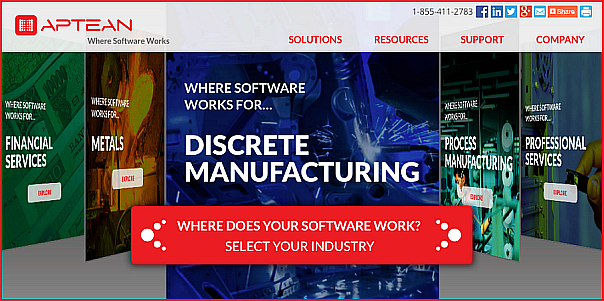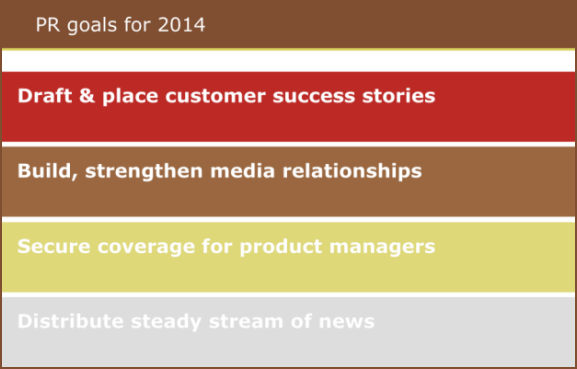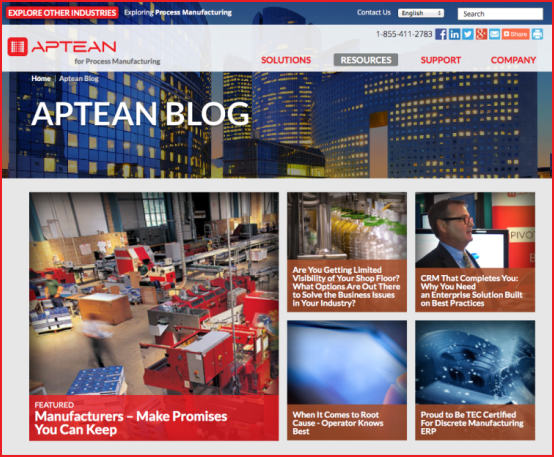by
David Kirkpatrick, Reporter
THE CUSTOMER
Aptean is a global software company headquartered in the United States with 17 offices in Europe and the Asia Pacific region. It targets both manufacturing companies (including food and beverage processed manufacturing) and financial services businesses.
Will Haraway, Director of Global Marketing and Communications, Aptean, said the company's marketing targets executive-level customers because that's where large, enterprise software purchase decisions are made.
He added that another aspect of its sales and marketing process is the importance of Aptean's software to integrate with other enterprise-class software its target audience might already have in place.
CHALLENGE
Aptean wasn't "formed organically," according to Haraway. Rather, it "[was] formed by acquisition."
This has been a key issue with marketing for Aptean because the company — like many large B2Bs — was built by acquisition. Each of those acquired companies had "very strong products with good awareness and certainly good R-and-D (research and development) behind it." Haraway added that each acquired company also had good customer histories. All of these attributes were a net positive for Aptean.
However, Haraway said, "the other side of that is you had … all these different brands. The challenge was to create an Aptean brand in a way that the products had more brand awareness than the company itself because there was just a longer history."
To provide an example, he said Aptean was formed via a merger in 2012, and one of the other acquired brands had more than 10 years of history in the marketplace.
"We were all very excited about having that blank slate in a way — to really talk to customers, talk to people who had been with the companies for a long time and really determine what was the heart of what the new company needed to be all about," Haraway said.
CAMPAIGN
The rebranding effort included a website redesign, a focus on search engine marketing (SEM), public relations, lead gen and lead nurturing. It also included research and planning around the entire marketing strategy before beginning the campaign.
At the same time, there was some urgency. Haraway said the effort began in earnest at the end of 2013, and Aptean had a user conference scheduled for mid-May 2014.
"We had no choice," he said. "It had to be live when the CEO stepped out on the stage and said, 'Here's our new brand.'"
Tactic #1. Redesign the website
In describing the CEO debuting the new brand to the user conference, Haraway was specifically referring to the website, which was the priority for the rebranding campaign.
He said the previous website was a lot of different companies and products flowing into one website. In fact, once the team was finished mapping the old site, they found 800 pages spanning products and companies that had simply been added to over the years.
From there, the redesign group worked with the product management team to figure out what products the new website should feature.
It turned out there was a lot of information on products that still existed, but these products weren't being actively sold. That material needed to have a place on the new website but didn't need to be what was described as "up front and center."
This process uncovered eight key products to feature and also acknowledged that Aptean served very different marketplaces — from food manufacturing to financial institutions — with its software. The decision was made to make the new site dynamic in that visitors could quickly select their industry and all the content would shuffle to meet their specific needs.
The redesign process also involved research on six of Aptean's direct competitors' websites.
Although the
new website was no longer a bloated 800 pages, it did include more than a thousand discrete parts that were dynamically built to each visitor after they selected an industry.

Click here to see the full version of this creative sample
Tactic #2. Execute search engine marketing tactics
The initial stage of SEM for the rebranding was keyword research for CRM, ERP and supply chain industries — particularly looking for long-tail keywords. This was because Aptean's business space was very competitive with many large competitors, such as Salesforce.com.
This research was first put to use to create optimized content to improve SEO in those key focus areas. An example would be a page titled, "What is CRM in food manufacturing?"
Paid search was implemented more strategically around specific products and industries to also boost SEO. The team realized it was going to take time to reindex the new website by search engines and that the site would also need time to recover recover from an initial drop in organic search performance. PPC ads were also utilized for new product launches.
Another SEO tactic the team deployed was creating relatively simple pages answering FAQs such as, "What is CRM?" These were in place more for search engines and to serve as a gateway for visitors to reach the website and more industry-specific content rich areas of the site.
Tactic #3. Remember public relations still has a role in marketing
Haraway said having the user conference deadline was "daunting," but it also provided an endpoint for the website redesign and rebranding. This provided a positive impact on the
PR campaign.
Click here to see the full version of this creative sample
"It's so important in PR to always have a compelling event that drives placements and drives the news," he said.
Haraway added, "We knew we would have all of our most interested media at the event … We worked toward that as the big bang."
He said the event was "everything" from launching the new brand, the new tagline and the new strategy. It was especially important to have the CEO available at the event to speak with the media about the rebranding and new direction of Aptean.
Part of the PR effort included building relationships with both members of the media and analysts who would be validating Aptean's messaging and product direction. At the user conference, the team made customers and internal experts at Aptean available to speak about industry-specific initiatives covered at the event.
A major aspect of the PR effort was transparency in providing information from executives, employees and customers of Aptean with the goal of having the messaging taken at face value and conveyed in the manner the team wanted it to be presented by the media.
Tactic #4. Take advantage of the brand overhaul to improve lead generation
Haraway said leading up to the brand relaunch, Aptean began running webinars on its products to build leads from existing and new customers. He explained that an important message at the user conference was how different Aptean products worked together because many of its existing customers only used one product.
Because the entire marketing strategy was being revamped along with the brand, there were opportunities to create very integrated lead gen campaigns. For example, Aptean has a complaint management tool and, in building out a lead gen effort for that product, the entire team worked together in multiple areas:
- Public relations to develop thought leadership
- Media relations to create "genuine noise" around the product
- SEM to drive people to the product's microsite
- Webinars, trade show activities and premium content that directly generate new leads
For that product, the team executed a benchmark survey in the product's technology space, placed bylined articles and case studies in industry publications and utilized webinars and traditional marketing, such as print and email marketing — all in the service of a comprehensive lead gen campaign.
Once those leads were generated, the team utilized
content to maintain momentum and interest.

Click here to see the full version of this creative sample
The major content piece for Aptean's lead nurturing was industry-specific newsletters. This content included thought leadership pieces and curated content.
RESULTS
The most important result of Aptean's rebranding campaign is a $21 million sales pipeline that can be directly attributed to marketing efforts.
Other metrics from the effort include:
- Website traffic increased year-over-year 36.62%
- Organic search traffic grew 52.58%
- A multi-touch drip marketing campaign generated 200 leads
- Media relations efforts generated 32 placements of bylined articles and interviews
About the entire rebranding effort, Haraway said, "I love the fact [that] we were able to take something that was so large and, from a communications perspective at least, so many different pieces — so many different directions that it could go — and pick one, unified vision and drive everything toward it."
He said the campaign included thinking about the reputation and characteristics of the company and its products and then finding people both within and outside the company who really understood Aptean.
With that in place, Haraway said the entire process was following "a clear roadmap as to where we needed to go and how we needed to get there and the stories that needed to be told."
Creative Samples
- New homepage
- PR goals chart
- Company blog
Sources
ApteanArketi Group — Aptean's marketing vendor
Related Resources
Stop by the
MarketingSherpa Media Center at IRCE 2015 to learn strategies from successful ecommerce marketers.
MarketingSherpa Summit 2016: Call for SpeakersB2B Marketing: Manufacturer's "Cheaper than China" branding campaign increases sales 33%B2B Ecommerce: Revamped online branding and cross-linked site search drives 17% of B2B revenueBranding: Online-focused rebranding increases website traffic 20%, Facebook fans 1,000%, YouTube subscribers 70%












